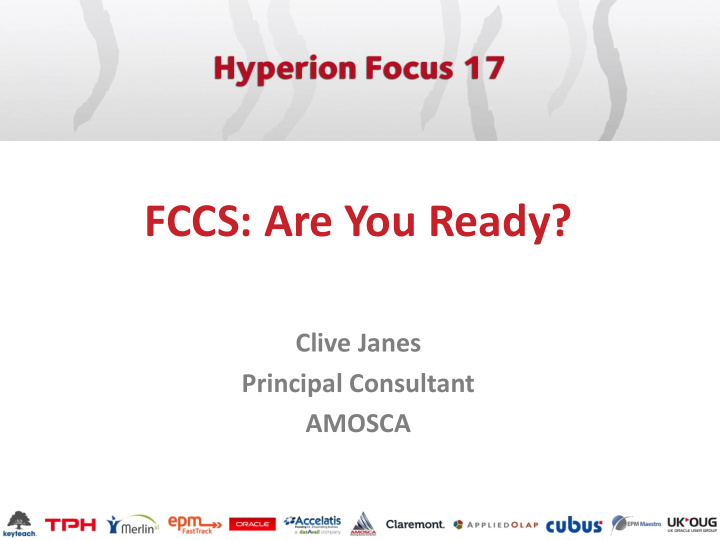



FCCS: Are You Ready? Clive Janes Principal Consultant AMOSCA
Agenda • What is FCCS • What do you get with FCCS • FCCS Demo • Comparing FCCS to HFM • Q & A FCCS Home Page
What is FCCS • Financial Consolidation and Close Cloud Service Cloud based solution for running financial consolidations and reporting » • Important to note: FCCS is NOT HFM in the cloud • This is a new product re-architected with Essbase backend and new UI Out-of-the-Box provides a framework model for best practice consolidation » • For Management and Statutory reporting • Pre-configured dimensions and Pre-seeded hierarchies • Ability to expand on the pre-built framework to meet individual business requirements Provides an End-to-End solution » • Data Collection and Integration Supplemental Data Manager » Data Management » • Consolidation • Close Process Management • Reporting • No requirement to manage infrastructure, software maintenance / patching Software updates are automatic from Oracle » The customer will always have the latest version »
What do you get with FCCS • Financial Consolidation Configuration - guided wizard for application creation » Pre-configured dimensions and Pre-seeded hierarchies to accelerate deployment » Limited customisation - metadata expansion and member calculations » Out-of-the-Box features: » • Currency translation • Intercompany eliminations • Calculations for e.g. CTA and ratios • Automated Cash Flow (requires metadata expansion to the Account and Movement dimensions) • Pre-built data forms, reports and dashboards Test and Production environments » • Data Management (FDMEE ‘ Lite ’) For loading data from source systems » • Integration with other cloud services e.g. NetSuite, PBCS • File based for non cloud systems • Supplemental Data Manager Collect lower level detail e.g. » • Maturity dates for investments • Supplemental disclosure notes for legal reporting Ability to validate totals against FCCS balances » • Close Manager Provides a way to manage workflow and close tasks (different model to HFM) » Enforces segregation of duties through e.g. submission and approval of journals »
What do you get with FCCS FCCS Dimensions Dimension Description Configuration Options Scenario Actual Additional Scenarios can be added Year 2016 through to 2040 The span of years for the application 12 or 13 period financial year can be Pre-defined System Dimensions Period Month (Jan - Dec), Quarters, Half Years selected with Quarters and Half Years View Year-to-Date or Periodic Periodic, YTD, QTD and HYTD Entity Consolidation reporting hierarchies Can have additional alternate hierarchies Consolidation Elimination, Proportion and Consolidation Currency Currency Account Chart of Accounts Intercompany List of Entities that take part in Intercompany transactions Movement Balance Sheet movements and Cash Flow Used to generate the Cash Flow e.g. separate members for GL load and Data Source Track the sources of data manual input Option to have IFRS adjustment Multi-GAPP Multiple GAAP reporting Optional calculated or input Maximum two Custom dimensions to provide additional Only one spare Custom dimension if Custom 1 - 2 analysis Multi-GAAP is selected
What do you get with FCCS Pre-Seeded Hierarchies FCCS_XXX ‘Out -of-the- Box’ seeded members Metadata expanded for business requirements Income Statement hierarchy located within the Balance Sheet
What do you get with FCCS Automated Cash Flow Automated Cash Flow is supported within the pre-built Movement dimension An alternate Movement hierarchy is provided for Cash Flow The basic structure for the Cash Flow is provided: • FCCS_Operating/Investing, etc. • But sufficient additional granular movement detail to identify cash and non-cash elements needs to be added
FCCS Demo
Comparing FCCS to HFM HFM FCCS FCCS Future Enhancements • On-premise or 3rd Party hosted • No need to pay for hardware or Infrastructure and • IT and application support Support support the infrastructure • Application support still needed required • Manage patching process • Applied automatically; Versions timings in house currently monthly • May need to add new hardware • Add new user licences Scalability • Unlimited applications • One application per instance • Limitations on members • Customisable rules for • Out-of-the-Box rules • Advanced consolidations for Rules • Limited customisation e.g. Calculations, Translations and e.g. JVs, Equity elim • Custom calcs (CalcManager) Consolidations member calculations • 8 standard dimension plus • Max two Customs (depends on • Ability to create additional Dimensions configurable number of Custom application creation options) Custom dimensions • Pre-defined Custom dimensions dimensions e.g. Multi-GAAP, Data Source • HFM client, EPMA, 3rd Party • Web interface and SmartView Metadata Management • Customisable e.g. Income • Income, Expense, Asset, Signage positive, Expense negative Liability all positive • PVA or VAL methods • PVA method only Consolidation/Translation • FDMEE, SDM, CM separate • All part of the package Licensing
Comparing FCCS to HFM Considerations • New product and still evolving compared to HFM. • No conversion utility from HFM to FCCS (possible in the future). • Limited as a reporting solution e.g. not able to embed detailed Tax Reporting, Tax Reporting Cloud Service would need to be purchased. • FCCS not completely ‘Out -of-the- Box’ » Still requires significant application design and development effort. • FCCS is easily scalable (add user licences to scale up). • FCCS is NOT HFM in the cloud » HFM applications and reporting processes would need to be evaluated and redesigned before moving to FCCS.
Q & A • Any Questions?
Thank you
Recommend
More recommend